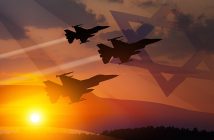
By Chris Flaherty
My Space Warfare Analysis Lab
INTRODUCTION
In science fiction the Space Marine is well established. The 1953 American movie – Project Moon Base – featured a U.S. Space Force, and even depicted its Space Station displaying USSF (United States Space Force) on its hull (Galaxy Pictures Incorporated, 1953).
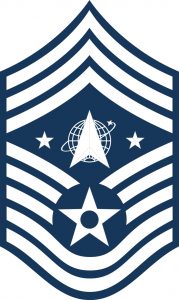
“▲ A 2021 version of the rank insignia for a U.S. Space Force Chief Master Sergeant.”
The 1953 film portrayed its USSF personnel on the Station wearing somewhat outlandish uniforms. Nevertheless when true Astronaut-Combatants began to be established, as an outcome of the 1967 Outer Space Treaty, this saw the creation of special uniform insignia. Between 1965, and 1984 special Personal Defence Weapons were designed and built for Soldiers in Space, or on the Lunar Surface (these will be reviewed at the end of this paper).
The notion of Human Astronaut-Combatant armed with a Personal Defence Weapon reflected the potential role these, from the late 1950s, till the mid-1980s, were presumed to have in a future Space War. Following the 1991 Persian Gulf War, the military-use satellite became a predominate fixture in Space Warfare Concepts, and the direct Human role correspondingly declined. A radical departure took place in the form of a physical separation of the Human controller from potential Space weapons, as these took the form of Satellite Kill Vehicles, and Space-Based Laser Batteries, with their Human controllers on the Ground.
The increased presence of Humans in Space might see, as a consequence, a return of the Human, as a direct actor in military or policing activity in Space. This paper will look at the Space Guardian as a next-stage of the development of the Astronaut-Combatant. This paper will also look at the idea of the Companion Robotic-Astronaut-Soldier as a further extension of the Human Soldier in Space. The paper will explore the notion of how a likely outcome of future Space Forces development will be collaborative International Forces mandated with Planetary Defence tasks, and policing of the peaceful use of Space, and other worlds by Human or Robotic actors, in keeping with the fundamental principle of the 1967 Outer Space Treaty – “Astronauts shall be regarded as the envoys of Mankind” (United Nations).
THE ASTRONAUT-COMBATANT
The notion of Human Combatants in Space is not new. Soviet early 1970s programs initially entertained the notion of their Laser Cannon equipped Polyus Spacecraft, or the missile-armed Kaskad Space Station, likewise housing two Cosmonauts for up to a week (Day, 2010; Gruntman, 2015). Use of Astronaut’s operating weapons, has been superseded in contemporary concepts about Space Warfare. The conventional thinking currently, in regards to the future training of the U.S. Space Force,
“industry is already thinking about how it can provide future Space warriors with simulators and training equipment to prepare for battle … these skirmishes likely won’t include hand-to-hand combat in full Astronaut gear” (Tadjdeh, 2018).
Even though, it can be anticipated that an Astronaut, who is also a military person, may be present in Space, such as a crew person on a Space Station, or crew person on a Human Space Flight Mission, these are not likely to be a potential Combatant. The prevailing thinking about a Space War if it were to occur:
“would be fought solely with uncrewed vehicles controlled by operators on the ground” (Reesman, 2020).
This is in line with one of the major assumptions about the conduct of a near-future Space War, namely:
“one of the key differences of Space Warfare, at least for the near future, will be the spatial separation of Human Combatants from their weaponry.” (Ramey, 2000)
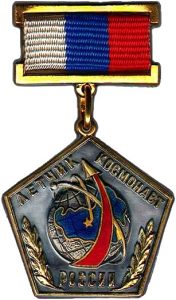
“▲ Established in 1992 the Pilot-Cosmonaut of the Russian Federation. The earlier 1961 badge was for the Pilot-Cosmonaut of the USSR (СССР).”
A variation of the Human Space Combatant was the U.S. Marines Jet-Battalion, conceived in the early 1960s, who would ride a Space rocket to transport them to be landed on the other side of the world in less than an hour via a ballistic transport system. It was anticipated the Marines, “upon landing … would have exited the rocket via jetpacks” (Weintz, 2015). While the Marine Jet-Battalion never eventuated, units like the U.S. Army Astronaut Detachment did arise, and this maintains a small group of, “Soldier Astronauts” (U.S. Army, 2018). The Detachment’s role,
“[is to support]… NASA with flight crew members and … [provide]… engineering expertise for Human interface with Space systems” (U.S. Army, 2020).
In 2020, a unique transfer occurred, while on the International Space Station when NASA Astronaut Mike Hopkins, was sworn into the U.S. Space Force (Erwin, 2020).
As a corollary, the 2020 announcement was made that personnel in the U.S. Space Force will be called Guardians (Garamon, 2020). Likely chosen to achieve a less military-sounding role, in keeping with the requirement to keep in step with an ongoing demilitarization of Space.
The notion of a soldier in Space category is not just historical, in terms of the military association with the formation of the early Space Program, it is also driven by the Laws of War, which have created the notion of the Astronaut-Combatant:
“A necessary precondition for any Astronaut claiming Combatant status … As applied to Space Warfare, this might mean that a Combatant who enters an opposing Spacecraft cannot be considered a spy as long as his vessel bears its prescribed distinctive markings, and the Astronaut wears his military uniform.” (Worden, 2002)
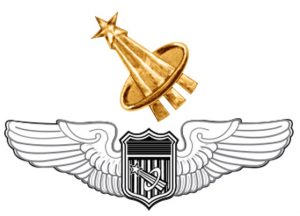
“▲ The United States Astronaut Badge. A qualification awarded since the 1960s. This version is for the United States Airforce with its Astronaut Device.”
The ‘distinctive markings’ requirement in Space Law has historically been adhered to, through Spacecraft livery being used, also displaying national-organisational attributions, set colour schemes, and Astronaut Spacesuits displaying national flag patches. It is for this reason since the 1960s, both the United States and the Soviets (later the Russian Federation) implemented qualification badges for their Astronauts and Cosmonaut programs. More recently the U.S. Space Force is in the process of designing its distinctive uniform insignia. Several examples of these insignia are illustrated in this paper
THE 1967 OUTER SPACE TREATY
The central question is how does the Astronaut-Combatant fall into the Weaponization of Space? (Remuss, 2011) Implicitly, the 1967 Outer Space Treaty, using similar language to the Antarctic Treaty of 1959, “explicitly states that the use of military personnel for peaceful purposes shall not be prohibited.” (Remuss, 2011) The intersection of the Treaty bans, and the Military Astronaut, is where there is use-operation of banned Weapons of Mass Destruction stationed in Outer Space. Under the Treaty military activities on celestial bodies are prohibited (United Nations). The Treaty bans also prohibits military exercises in Space, or the Moon, or presumably, an ‘other world’ like Mars, as these areas are:
“classified as a demilitarized zone much as it was in the Outer Space Treaty; however, an entire article is devoted to this, expressly prohibiting ‘hostile act[s]or threat[s]of hostile act[s]on the Moon’. Moreover, this article even prohibits ‘[t]he establishment of military bases, installations and fortification, the testing of any type of weapons and the conduct of military [manoeuvres]on the Moon” (Crockett, 2012).
The basic posture has been, “responsible, peaceful, and safe use of Space.” (USSPACECOM, 2021) If viewed from the perspective of their being a radical and massive technology shift in transportation into Space, and permanent Human presence in Space, on the Earth’s Moon, and Mars in far greater numbers than seen historically, this may fundamentally shift the basic gearing underpinning the 1967 Outer Space Treaty. A practical necessity emerges, “[to]… protect and defend … against any foreign Space-related aggression … [including Space itself].” (USSPACECOM, 2021)
The conventional view is to look at this later proposition in terms of hostile acts towards an asset like a satellite, that is being protected by a conventional Space Force, in a military-like situation. The original language of the 1967 Outer Space Treaty envisaged scenarios characterized as singular activity in Space. The problem is exacerbated where Humans have not only a routine presence in Space, but this is on a significantly larger scale than has been technologically, or economically possible in the past. For instance, at the time of writing this paper (June-July 2021), there are currently 10 people in Space, there are seven crew on the International Space Station, and three crew on the Tiangong Space Station. In the near-future this shifts dramatically as the Human population in Space increases tenfold (or more), through: (1) Space Tourism short-duration rides into Low Earth Orbit (Spaceplanes), and Suborbital trips (in capsules); (2) The existing Space Stations are increased in size to accommodate more visitors, a third and fourth Space Stations – Factories are added; (3) At least two, possibly three missions on the Moon, establishing Human habitats; and, (4) The Moon settlement-bases are being serviced with a Starship carrying 100 Humans to the Moon. The increase in Human Space activity necessitates a shift from the ‘peaceful Astronaut’ into an Astronaut involved in the development of Space Security (Remuss, 2011).
It is conceivable that a scenario may arise based on the notion of a third-party threat, where the aggressive, threatening, or dangerous behaviour is being exhibited by one Astronaut in a Spacecraft, against another, or by Humans on the surface of the Moon, or Mars. The question becomes given time-lag in communications, between Ground Control and the individuals, and the lack of effective situational awareness – to avoid catastrophe, that a third-party – called the, “Space Sheriff Scenario” (Remuss, 2011), may be a solution. Early thinking in the mid-to-late 1950s, emphasized the effectiveness of Human intervention, in the use of weapons in Space. This lay at the heart of the original U.S. Airforce requirement for a Human pilot in the Space Bomber, the benefit of which:
“is the belief that Human Beings possess inherent advantages over machines, particularly in terms of on-the-spot judgment and flexibility.” (Sambaluk, 2011)
The presence of Astronaut-Combatant acting as a Space Sheriff could become an outcome of an expanding set of scenarios, where a Human component is finally needed – ‘to go up there’. Sent-up (launched from Earth), sent from a Space Station, or based on the Moon, or Mars. Adding Humans to the mix, allows exploitation of unpredictability, as a Human can make ‘on the ground tactical assessments’, make sudden tactical decisions, and execute these.
Under the current formulation of Space Law, the presence of a Space Sheriff, which in reality would be a Space Force Astronaut, may be regarded as belonging to banned activities in Space, or another world like the Moon, creating a military establishment, military base, installations, or fortification, or the conduct of military manoeuvres. Direct action may also be problematic, as an Astronaut-Combatant acting as a Space Sheriff, effectively:
“runs afoul of the fundamental principle of Space Law that Astronauts, regardless of their nationality or affiliation, should be treated as ‘envoys of mankind’ and receive all reasonably possible support, as well as the right to be repatriated to their home State as soon as possible.” (Dunk, 2021)
The original language of the 1967 Outer Space Treaty, was predicated on scenarios involving rendering assistance to the Astronaut of another state where they were in distress, and the source of that distress was some Space phenomenon, craft or systems failure. The legal proposition looks at the Astronaut as passively involved in singular, peaceful and neutral activities, unless rendering assistance is called upon, by another Astronaut in distress; and if they are from a foreign country they must be repatriated. A massive Human surge in Space would fundamentally change the nature of a Space Force, making it operate along a spectrum: military force, police, commerce authority, and coast guard in Low Earth Orbit, Cislunar and Mars Space. Broadly, analogous to ancillary Humanitarian, and aid to civil authorities roles played by the U.S. military globally:
“frequently asked to prevent loss of life or property, or to help in recovery from natural or man-made hazards such as humanitarian relief operations, non-combatant evacuation operations, rescue, and assistance at sea. In keeping with these non-core, but traditional military roles, as commercial activity moves further into Space, military Space Forces will likely be called upon to provide similar support to commercial actors and scientific missions.” (Buehler, 2021)
COMPANION ROBOTIC-ASTRONAUT-SOLDIER
Current military combat robots are mostly vehicles and flying craft. The notion of a Robotic Astronaut-Soldier is a hypothetical; nevertheless the technology is a growing possibility. Since 2000, including currently, research and development programs have built several bipedal Humanoid-looking Astronaut’s assistant robots. Examples include the NASA Robonaut-2 Project (NASA, 2019); and, Russian F.E.D.O.R. Platform (Androidnaya Tekhnika, 2019). The aim has been to build a robot that can do the same jobs as a Human. The underlying design philosophy has been that rather than build two sets of systems in a Spacecraft, on a Space Station, or at a Space Base one for the Human to use, the other for the robot to use – which would lead to an unnecessary duplication of controls, functions and roles, the robot is intended to be able to operate the same controls as a Human, in a variety of scenarios. Appearance wise, the Humanoid robot have a head (which is packed with cameras and sensors), torso (that holds hardware), and carries a backpack battery. Fitted with dexterous arms, legs, and hands, its fingers replicate Human movement and functionality, and this allows the robot to perform tasks designed to be done by human hands, and use the same tools as an Astronaut.
The question arises, what would result in a convergence of Space Program technology into a Robotic Astronaut-Soldier, and how would it be used? Scenarios could be considered such as the substitution of one of the Human Astronaut-Soldiers with a robot. Current development of the Astronaut’s assistant robot have software allowing it to ‘think-for-itself’, performing simple tasks. It also can be operated by remote control, with the operator’s headset seeing what the robot sees through its cameras. It is possible to consider the scenario where a Military Astronaut plays a Space Security role and is physically in the same area of Space, or acting through a proxy – a Robotic Astronaut-Soldier, with a distant Human operator, not unlike current drone pilots. Even though a Robotic Astronaut-Soldier is Human-like and replicates Human movement and behaviour, it is also capable of a range of radical tactical manoeuvre and possible weapons handling.
In 2017, the Russian F.E.D.O.R. was demonstrated holding in each hand a pistol, that it could fire pulling the triggers. This was done to demonstrate its fine motor skills. Further development based on Dynamic Humanoid Robots (Boston Dynamics Atlas), and Robonaut-2 Next Generation Dexterous Robots, raises issues about how a robot can potentially out-perform a Human. It is conceivable that the robot version of the Astronaut given its superior physical speed and strength, unless these were deliberately ‘dial-back’ to a Human-level, would be used to act in lieu of a Human Astronaut. Acting as an extension of the Human soldier in Space may have implications for the notion of the Astronaut-Combatant as a Space Sheriff as the next-stage development. The proxy robot if used to out-perform its opponent raises a strong possibility of easy harm. Such as the risk of excessive force being applied by robot hands, leading to the puncture of a Space Suit, that catastrophically causes the death of an Astronaut, in policing and security circumstance that only required minimal deterrence action. The death in Space would be a direct violation of the 1967 Outer Space Treaty.
SPACE SOLDIER’S PERSONAL DEFENCE WEAPONS
The remaining section in this paper will overview the development between 1965, and 1984, of special Personal Defence Weapons intended to be used by United States or Soviet Soldiers in Space, or on the Lunar Surface in potential combat situations. The object was to design weapons that could be specifically used in Space, or on the surface of the Moon. A 1965 U.S. Army study identified several plausible hand-held presumably smoothbore weapons options, with a much reduced recoil (equivalent to the Moon’s gravitational field which is notionally a sixth that of the Earth). The type of weapons proposed used a variety of systems to propel a projectile such as compressed springs, gas blasts, or a Gyrojet Projectile: a small bullet micro-rocket packed with its own propellent. It also appears, that all the proposed weapons designs were aimed at the need to keep, “weapon weight at a minimum.” (U.S. Army, 1965)
U.S. Space Soldier’ Personal Defence Weapons
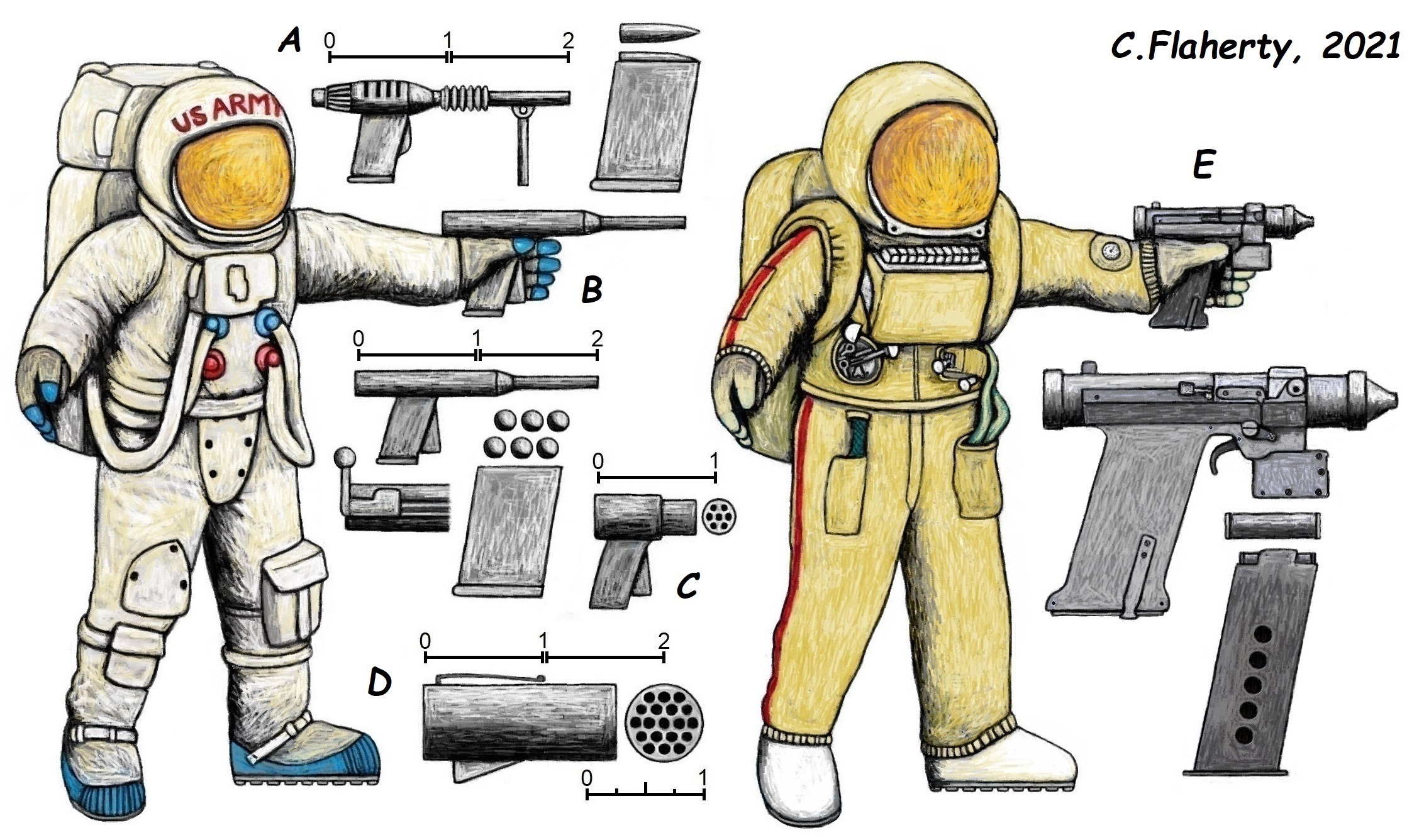
“▲ A U.S. Army Specialist: Astronaut-Combatant, and Armed Cosmonaut as they might have appeared (around 1965-1984), on the Lunar Surface, or in Space.”
A. 1965 US Army Gyrojet Projectile Pistol (Semiautomatic). This is one of several concept weapons developed for Lunar Surface Combat (U.S. Army, 1965). The magazine proposed for this handgun contained 30-50 small bullet micro-rockets, each packed with its own propellent.
B. Wearing a NASA Spacesuit, a U.S. Army Specialist: Astronaut-Combatant is depicted firing another 1965 U.S. Army Concept Weapon, in this case a Compressed Spring Propelled Spherical Projectile Handgun (Long barrelled).
C. Directed Gas Weapon for close-in fighting (1965 U.S. Army Concept Weapon): Its seven single-shot gas blasts were intended to breach a Spacesuit.
D. Sausage Gun (1965 U.S. Army Concept Weapon): It was also based on the Gyrojet Projectile Principle – firing by electrical ignition a small bullet micro-rocket.
Soviet Cosmonaut Personal Defence Weapons
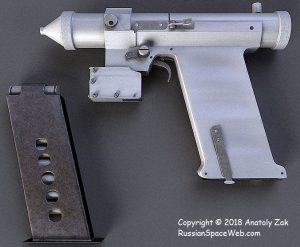 E. The Russian 1967 Lunar Surface Krechet-94 Space Suit. The Soviet Cosmonaut is depicted using a Laser Pistol designed for close-in combat on a Space Station. The Soviets around 1984, developed a Laser Pistol that used a lamp-cartridge loaded pyrotechnic flash, with a blinding force up to a range of 20 meters: 65 feet (Zak, 2018). The Laser Pistol was intended to ‘flash blind’ an opponent in close-in fighting, such as during a hostile Spacecraft boarding action.
E. The Russian 1967 Lunar Surface Krechet-94 Space Suit. The Soviet Cosmonaut is depicted using a Laser Pistol designed for close-in combat on a Space Station. The Soviets around 1984, developed a Laser Pistol that used a lamp-cartridge loaded pyrotechnic flash, with a blinding force up to a range of 20 meters: 65 feet (Zak, 2018). The Laser Pistol was intended to ‘flash blind’ an opponent in close-in fighting, such as during a hostile Spacecraft boarding action.
The Soviets also devised a specially adapted R-23M Kartech, originally a powerful aircraft weapon, used on the then Tupolev Tu-22 Blinder Supersonic Bomber (Zak, 2015). The 23 millimetre cannon was used to arm the Salyut-3: OPS-2 (Almaz-2), around 1975,
“[it was]… an externally mounted machine gun cannon to defend against American Astronaut attacks.” (Reesman, 2020)
This weapon is understood to have not been recoilless, and its firing had the potential for shock and recoil,
“to damage the station but, in the vacuum of Space, those forces raised the possibility that shooting the weapon could send it flying in a dangerously unpredictable fashion … [the solution was]… ignited its jet thrusters simultaneously with firing the cannon to counteract the weapon’s powerful recoil” (Zak, 2015; Trevithick, 2021).
The 1965 till 1984 special Personal Defence Weapons intended to be used by United States or Soviet Soldiers in Space, or on the Lunar Surface in potential combat situations at the time defined Space Warfare. Human combat in Space never occurred. As a further extension of the Human Soldier in Space, as a near-future concept, it may see a return of the weapons. It may also combine with the Companion Robotic-Astronaut-Soldier. This would reverse a major military trend, seeing Humans leave Ground Control, returning to Space involved as direct actors in Space Security and policing activities, because of their pilot training, their tactical abilities, and training with weapons (Remuss, 2011).
THE SPACE GUARDIAN
This final section will explore the notion of how a likely outcome of future Space Forces development will be collaborative International Forces mandated with Planetary Defence tasks, Space Security and Space Policing of the peaceful use of Space, and on other worlds. This will be a complex sphere of activities, operating in Space, in harsh environments, by Human or Robotic actors, representing several nations, international coalitions, private corporate and international science organisations. In this complex environment the Astronaut-Combatant converts into a Space Guardian, or Space Sheriff. The Space Sheriff,
“could be tasked to enforce law and order in the settlement. Thinking of the ‘encounter of the unknown’, i.e. the contact of Humans with Extra-Terrestrials, ‘Space Sheriffs’ might be tasked to mediate between Humans and Extra-Terrestrials. Given these possible activities, Astronauts will be perceived as acting in some kind of policing function.” (Remuss, 2011)
Potential contact with Extra-Terrestrials, or policing the treatment – scientific preservation of Other-World Biology under the Committee of Space Research’s Planetary Protection Policy obligations (COSPAR, 2020; Cheney, 2020), form part of a gambit of Space Security scenarios, along with ordinary policing of Human-to-Human interactions, or possibly Human interactions with robots. These would sit below the relationship between various national, international, private and independent scientific enterprises in an increasingly crowded Space, Lunar, and Mars surfaces in the near-future. Further scenarios can also be envisaged such as Space Terrorism, and Space Piracy – which would lead to intervention by a Space Force for the protection of others, and the Space Force’s own country’s Space assets, and activities.
The question arises: how under Space Law does a Space Force policing-type organisation – the Space Guardian – get created? A large percentage of the Astronauts are military. It could be like the United Nations Peacekeepers, and would they need the support of a Space Super Power to operate? Would there be specific recruitment of Space Police? Is it the case that there might be a coalition-type arrangement between traditional allies who all have Space Forces – Commands, at varying levels of development that have a long history of Defence interoperation, and cooperation? This also needs to be viewed in the context of the recent June 2021 Brussels Summit Communique where NATO extended its mutual defence clause, known as Article 5, to cover, “potential attacks on or originating from Space.” (North Atlantic Treaty Organization, 2021) This can be interpreted potentially to include NATO Space Security operations, as the core members possess substantial Space Forces – Commands. Essentially this also has to be viewed in terms of a wider historical transformation of the Human role in Space Warfare, Space Security, and Planetary Defence.
FIGURE 1: The notion of the Human in Space, has undergone three distinct stages. The first of these was a direct outcome of the early Human Space Flight era, that created the Space Bomber, and crewed Orbital Battle Station. The 1967 Outer Space Treaty radically changed this direction, as did changes in Space Warfighting concepts that emphasized the military-use satellite. This ended the notion of Human Astronaut-Combatant armed with a Personal Defence Weapon; however, some of these weapons (the Laser Pistol, and modified machine cannon) were created as late as the mid-1980s, well after the Treaty Bans. The physical separation of Human control, residing in Ground Control facilities, from potential Space weapons in the form of Satellite Kill Vehicles, and Space-Based Laser Batteries, is expected to radically alter again in the near-future. Emergence of new Space Security concepts in the context of a mass-increase in Humans, tenfold over the small number of Human Astronauts currently in Space necessitates a need for policing: the so-called Space Sheriff. It can be posited, increased presence of Humans in Space might see a return of the Astronaut-Combatant, recast as a Space Guardian – Space Sheriff. It may be the case, these will use robot proxies, not unlike current drone operators. However such technology carries the risk of excessive force. Another possible direction of future Space Forces, could be less military, and more likely to develop as policing and civil defence entities: Space Coast Guards. This evolution, could be a likely extension of factors, such as Moon, and Mars settlement-bases under civil, and private corporation management, operating within a system of Space Law, Nation of Flag Registry, and under international auspices. This may see Space Forces used as policing, emergency and civil defence organisations, and largely dedicated to Planetary Defence, in which case the Orbital Battle Station transforms into the Planetary Defence Orbital Weapons Station.
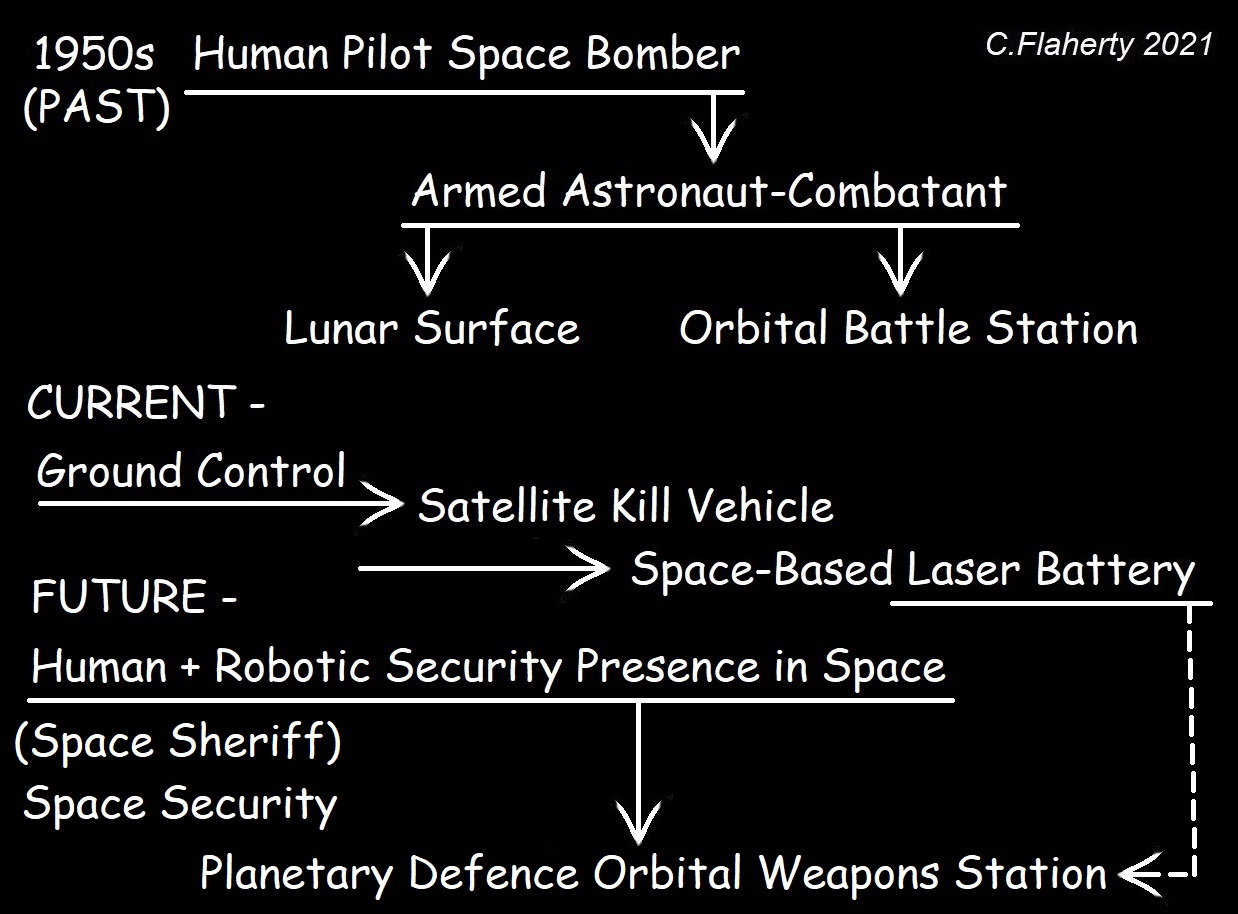
“▲ FIGURE 1: Historical Transformation of the Human Role in Space Warfare, Space Security, and Planetary Defence.”
- REFERENCES
- • Androidnaya Tekhnika. 2019 [-2015] F.E.D.O.R. Platform. Fact Sheet.
• North Atlantic Treaty Organization. 2021 Brussels Summit Communique. Press Release (2021) 086 (14 June).
• Boston Dynamics Atlas. Fact Sheet.
• Buehler, D. Felt, E. Finley, C. Garretson, P. Stearns, J. Williams, A. 2021 Posturing Space Forces for Operations Beyond Geo. Space Force Journal. Issue 1 (31 January).
• Cheney, T. Newman, C. Olsson-Francis, K. Steele, S. Pearson, V. Lee, S. 2020 Planetary Protection in the New Space Era: Science and Governance. Frontiers in Astronomy and Space Sciences (13 November).
• COSPAR [Committee of Space Research]. 2020 Policy on Planetary Protection. COSPAR Panel on Planetary Protection. Approved by the COSPAR Bureau (17 June).
• Crockett, J.W. 2012 Space Warfare in the Here and Now: The Rules of Engagement for U.S. Weaponized Satellites in the Current Legal Space Regime. Journal of Air Law and Commerce. Volume 77. Issue 4.
• Day, D.A. Kennedy, R.G. 2010 Soviet Star Wars: The Launch that Saved the World from Orbiting Laser Battle Stations. Air & Space Magazine (January).
• Dunk [von der], F.G. 2021 Armed Conflicts in Outer Space: Which Law Applies? International Law Studies. Volume 97.
• Erwin, S. 2020 NASA’s Crew-1 Commander to be Sworn into U.S. Space Force from the International Space Station. Space News (28 October).
• Galaxy Pictures Incorporated. 1953 Project Moon Base.
• Garamon, J. 2020 Space Force Personnel to be Called Guardians. U.S. Department of Defense News (19 December).
• Gruntman, M. 2015 Intercept 1961: The Birth of Soviet Missile Defense (Library of Flight). American Institute of Aeronautics and Astronautics Journal.
• NASA. 2019 Robonaut-2. Fact Sheet.
• Ramey, R.A. 2000 Armed Conflict on the Final Frontier: the Law of War in Space. The Air Force Law Review. Volume 48.
• Reesman, R. Wilson, J.R. 2020 The Physics of Space War: How Orbital Dynamics Constrain Space-to-Space Engagements. The Aerospace Corporation (October).
• Remuss, N-L. 2011 Astronauts: From Envoys of Mankind to Combatants. Schrogl, K-U. Landfester, U. Remuss, N-L. Worms, J-C. (Editors) Humans in Outer Space — Interdisciplinary Perspectives. Springer-Verlag Wien.
• Sambaluk, N.M. 2011 What’s a Heaven For? National Public Culture’s Role in Shaping U.S. Space Policy, Aerospace Doctrine, and the Future of the Dyna-Soar, 1957-61. Dissertation. The University of Kansas.
• Tadjdeh, Y. 2018 Training the Space Force: How the Military Will Prepare for Future Battles. National Defense Magazine (26 November).
• Trevithick, J. 2021 Here’s Our Best Look Yet at Russia’s Secretive Space Cannon, the Only Gun Ever Fired in Space. The War Zone (16 February).
• United Nations. Office for Outer Space Affairs (UNOOSA). Resolution Adopted by The General Assembly 2222 (XXI). Treaty on Principles Governing the Activities of States in the Exploration and Use of Outer Space, Including the Moon and Other Celestial Bodies.
• U.S. Army [United States Army]. 2020 United States Army Astronaut Detachment. U.S. Army Space and Missile Defense Command Public Affairs Office.
• U.S. Army [United States Army]. 2018 The Army Has Three Active-Duty Soldier-Astronauts. Mighty Tactical. We Are the Mighty Website (1 November).
• U.S. Army [United States Army]. 1965 The Meanderings of a Weapon Oriented Mind When Applied in a Vacuum Such as on the Moon. Headquarters Weapons Command Rock Island, Illinois (June, 652156).
• USSPACECOM [U.S. Space Command]. 2021 Never a Day Without Space: Commander’s Strategic Vision (January).
• Weintz, S. 2015 Space Marines With Jetpacks! War is Boring.
• Worden, S.P. Shaw, J.E. 2002 Whither Space Power? Forging a Strategy for the New Century. Fairchild Paper (September).
• Zak, A. 2018 The Soviet Laser Space Pistol, Revealed. Popular Mechanics (14 June).
• Zak, A. 2015 Here is the Soviet Union’s Secret Space Cannon. Popular Mechanics (16 November).
AUTHOR
Chris Flaherty authored the Terrorism Research Center’s report – Dangerous Minds (2012). He was the co-primary author, along with Robert J. Bunker of the book – Body Cavity Bombers: The New Martyrs (iUniverse, 2013). Two essays of his, from 2003 and 2010 were reprinted in the Terrorism Research Center’s book – Fifth Dimensional Operations (iUniverse, 2014). He recently contributed a book chapter – The Role of CCTV in Terrorist TTPs, edited by Dave Dilegge, Robert J. Bunker, John P. Sullivan, and Alma Keshavarz, the book – Blood and Concrete: 21st Century Conflict in Urban Centers and Megacities, a Small Wars Journal anthology, published on behalf of the Small Wars Foundation with Xlibris (2019). Chris Flaherty is currently a Space & Defense Tech and Security News Regular Contributor.
CONTACT DETAILS: Dr Chris Flaherty https://au.linkedin.com/in/drchrisflaherty


